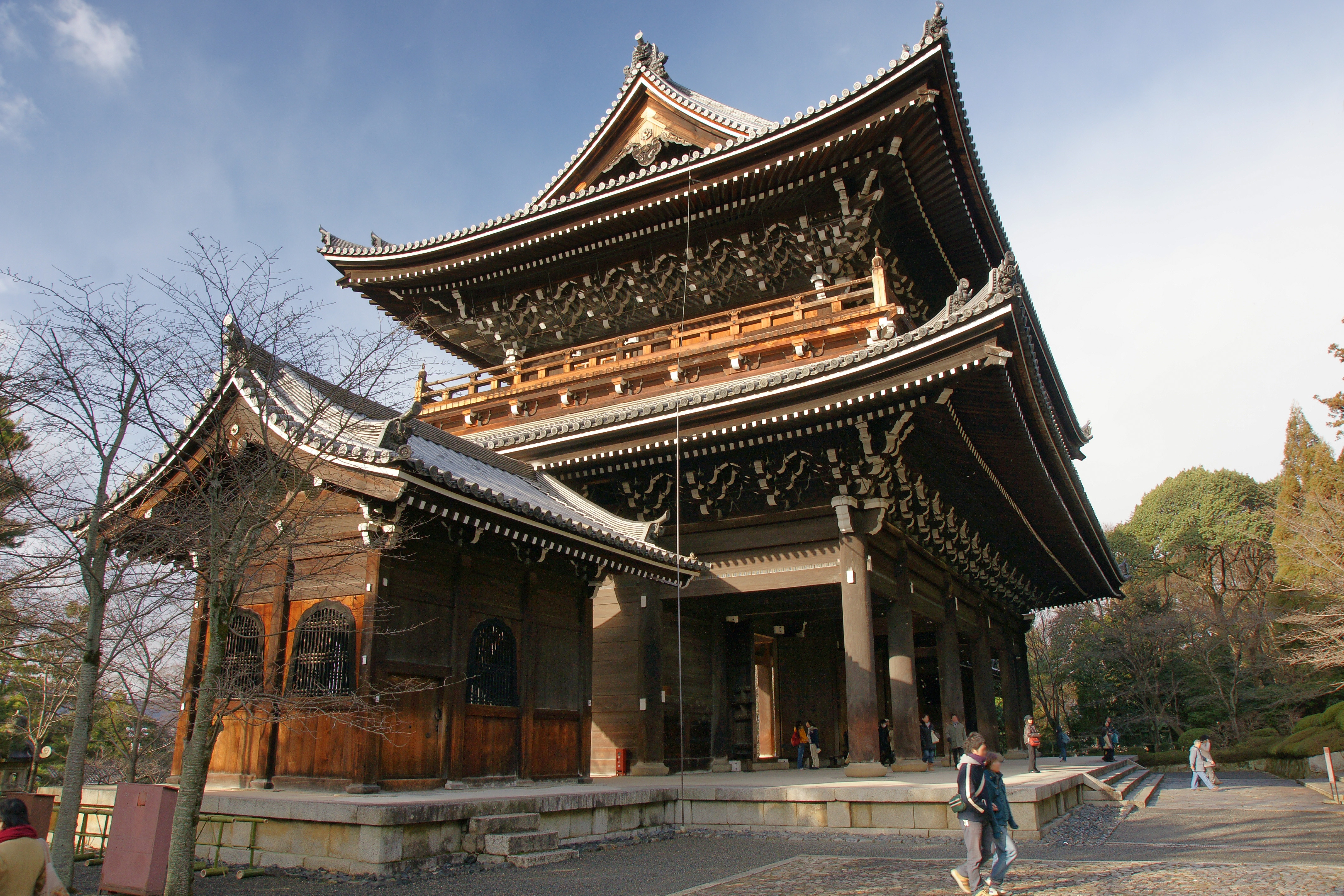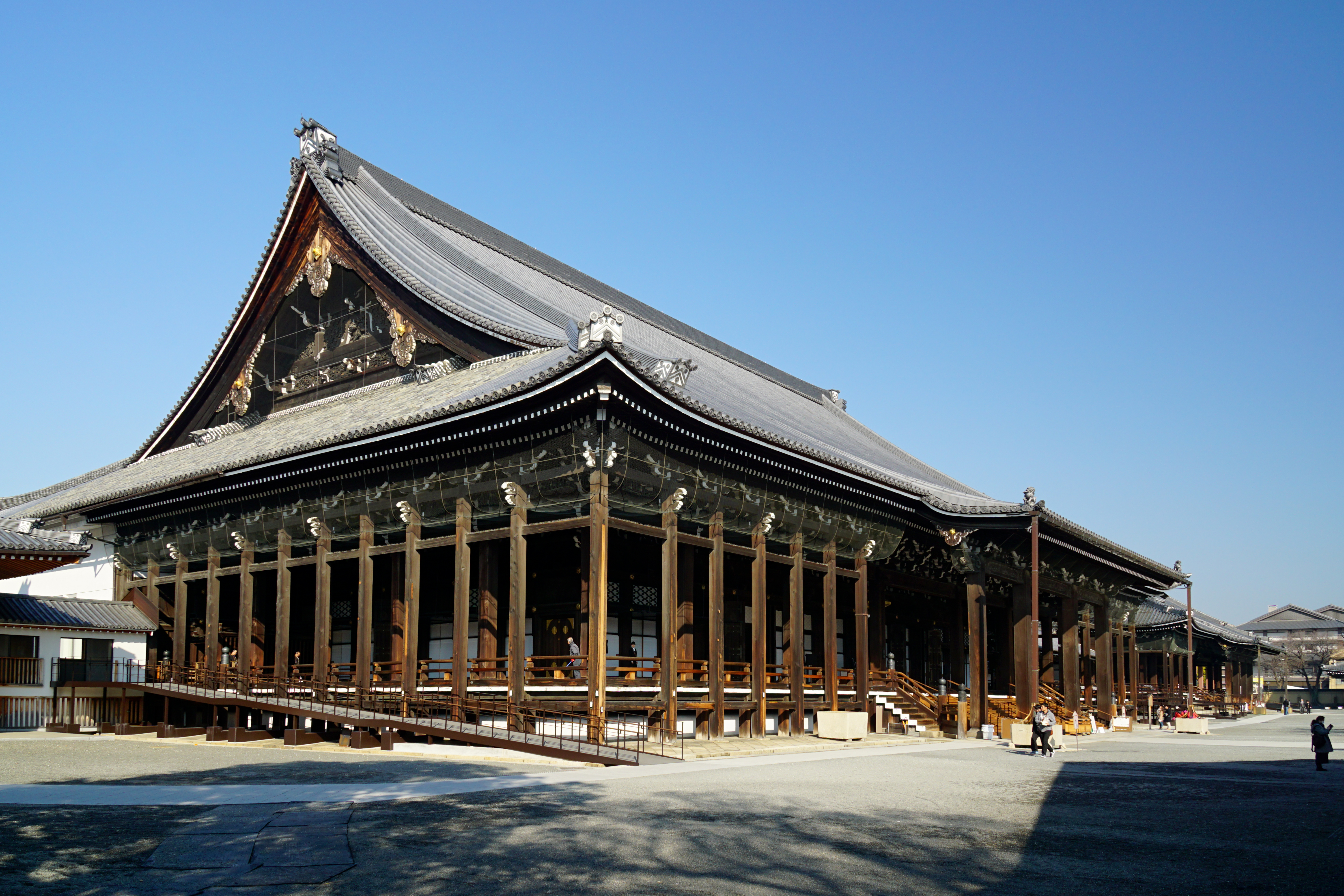|
Monshu
The Monshu (ķ¢ĆõĖ╗), or ''keeper of the gate'' is a term sometimes used in Japanese Buddhism to denote the head of a monastery, as in the case of J┼Źdo-sh┼½ and Tendai Buddhism, but in the case of the Nishi Hongan-ji sub-sect of J┼Źdo Shinsh┼½ Buddhism, it refers to the spiritual leader of the sect, and direct descendant of its founder Shinran. J┼Źdo Shinsh┼½ The Monshu in J┼Źdo Shinsh┼½ Buddhism was the guardian of Shinran's mausoleum, as well as the head of the sect. This position was started when the youngest daughter of Shinran, Kakushinni, installed her son as the custodian of the small shrine which held Shinran's image and ashes at ┼ītani, in Kyoto. In time the small shrine grew into what is now the Hongan-ji temples (east and west). When the temple split into two temples, the West Temple, or ''Nishi Honganji'' continued to use the term Monshu, while the East Temple, or ''Higashi Hongan-ji'' gradually adopted the term "Hossu". In the line of Monshu descendants, no ... [...More Info...] [...Related Items...] OR: [Wikipedia] [Google] [Baidu] |
Rennyo
Rennyo (, 1415ŌĆō1499) was the 8th Monshu (head priest) of the Hongan-ji Temple of the J┼Źdo Shinsh┼½ sect of Buddhism, and descendant of founder Shinran. Jodo Shinshu Buddhists often referred to as the restorer of the sect ( in Japanese). He was also known as ''Shinsh┼Ź-in'' (õ┐ĪĶ©╝ķÖó), and posthumously ''Et┼Ź Daishi'' (µģ¦ńü»Õż¦ÕĖ½). During the conflict of the ┼īnin War and the subsequent warfare that spread throughout Japan, Rennyo was able to unite most of the disparate factions of the Jodo Shinshu sect under the Hongan-ji, reform existing liturgy and practices, and broaden support among different classes of society. Through Rennyo's efforts, Jodo Shinshu grew to become the largest, most influential Buddhist sect in Japan. Rennyo is venerated along with Shinran, and liturgical reforms he implemented are still in use today in Jodo Shinshu temples. Further, Rennyo's letters were compiled and are still recited in Jodo Shinshu liturgy. Rennyo maintained a complex relationsh ... [...More Info...] [...Related Items...] OR: [Wikipedia] [Google] [Baidu] |
Shinran
''Popular Buddhism in Japan: Shin Buddhist Religion & Culture'' by Esben Andreasen, pp. 13, 14, 15, 17. University of Hawaii Press 1998, was a Japanese Buddhist monk, who was born in Hino (now a part of Fushimi, Kyoto) at the turbulent close of the Heian Period and lived during the Kamakura Period. Shinran was a pupil of H┼Źnen and the founder of what ultimately became the J┼Źdo Shinsh┼½ sect of Japanese Buddhism. Names Shinran's birthname was Matsuwakamaro. In accordance with Japanese customs, he has also gone by other names, including Hanen, Shakku and Zenshin, and then finally Shinran, which was derived by combining the names of Seshin (Vasubandhu in Japanese) and Donran ( TanluanŌĆÖs name in Japanese). His posthumous title was Kenshin Daishi. For a while, Shinran also went by the name Fujii Yoshizane. After he was disrobed, he called himself Gutoku Shinran, in a self-deprecating manner which means "stubble-haired foolish one," to denote his status as "neither a monk, nor a ... [...More Info...] [...Related Items...] OR: [Wikipedia] [Google] [Baidu] |
Kakunyo
Kakunyo (Ķ”ÜÕ”é) (1270-1351) is the great-grandson of Shinran, founder of J┼Źdo Shinsh┼½ Buddhism, and the third caretaker, or Monshu of the family mausoleum, which gradually became the Hongan-ji Temple in Kyoto Kyoto (; Japanese language, Japanese: , ''Ky┼Źto'' ), officially , is the capital city of Kyoto Prefecture in Japan. Located in the Kansai region on the island of Honshu, Kyoto forms a part of the Keihanshin, Keihanshin metropolitan area along wi ..., Japan. He was responsible for being the first to compile information about Shinran's life, and formalizing the new J┼Źdo Shinsh┼½ sect, while re-asserting power at the mausoleum away from Shinshu followers in the Kant┼Ź region. Kakunyo was an avid writer whose liturgies comprise an important part of J┼Źdo Shinsh┼½ services, while his biography on Shinran, the is still an important source for scholars. Mahayana Buddhists J┼Źdo Shinsh┼½ J┼Źdo Shinsh┼½ Buddhist priests Kamakura period Buddhist clergy {{buddhism ... [...More Info...] [...Related Items...] OR: [Wikipedia] [Google] [Baidu] |
Buddhism
Buddhism ( , ), also known as Buddha Dharma and Dharmavinaya (), is an Indian religion or philosophical tradition based on teachings attributed to the Buddha. It originated in northern India as a -movement in the 5th century BCE, and gradually spread throughout much of Asia via the Silk Road. It is the world's fourth-largest religion, with over 520 million followers (Buddhists) who comprise seven percent of the global population. The Buddha taught the Middle Way, a path of spiritual development that avoids both extreme asceticism and hedonism. It aims at liberation from clinging and craving to things which are impermanent (), incapable of satisfying ('), and without a lasting essence (), ending the cycle of death and rebirth (). A summary of this path is expressed in the Noble Eightfold Path, a training of the mind with observance of Buddhist ethics and meditation. Other widely observed practices include: monasticism; " taking refuge" in the Buddha, the , and the ; ... [...More Info...] [...Related Items...] OR: [Wikipedia] [Google] [Baidu] |
J┼Źdo-sh┼½
, also known as J┼Źdo Buddhism, is a branch of Pure Land Buddhism derived from the teachings of the Japanese ex-Tendai monk H┼Źnen. It was established in 1175 and is the most widely practiced branch of Buddhism in Japan, along with J┼Źdo Shinsh┼½. In the general classification of Buddhism in Japan, the J┼Źdo-sh┼½, the J┼Źdo Shinshu, the Ji-shu and the Yuzu Nembutsu, Yuzu Nembutsu shu are collectively classified into the lineage of J┼Źdo Buddhism. (J┼Źdo kei, µĄäÕ£¤ń│╗) History The Founder: H┼Źnen H┼Źnen (µ│ĢńäČ) was born in 1133, the son of Uruma no Tokikuni of a local ruling family in Mimasaka Province. H┼Źnen was originally named Seishimaru after the mah─üsattva Seishi (Sanskrit Mahasthamaprapta, Mah─üsth─ümapr─üpta). After a rival official assassinated his father in 1141, H┼Źnen was initiated into his uncle's monastery at the age of 9. From then on, H┼Źnen lived his life as a monk and eventually studied at the famous monastery of Mount Hiei. H┼Źnen was well respect ... [...More Info...] [...Related Items...] OR: [Wikipedia] [Google] [Baidu] |
Tendai
, also known as the Tendai Lotus School (Õż®ÕÅ░µ│ĢĶŻիŚ ''Tendai hokke sh┼½,'' sometimes just "''hokke sh┼½''") is a Mah─üy─üna Buddhist tradition (with significant esoteric elements) officially established in Japan in 806 by the Japanese monk Saich┼Ź ( posthumously known as Dengy┼Ź Daishi). The Tendai school, which has been based on Mount Hiei since its inception, rose to prominence during the Heian period (794-1185). It gradually eclipsed the powerful ''Hoss┼Ź'' school and competed with the rival Shingon school to become the most influential sect at the Imperial court. By the Kamakura period (1185-1333), Tendai had become one of the dominant forms of Japanese Buddhism, with numerous temples and vast landholdings. During the Kamakura period, various monks left Tendai (seeing it as corrupt) to establish their own "new" or "Kamakura" Buddhist schools such as J┼Źdo-sh┼½, Nichiren-sh┼½ and S┼Źt┼Ź Zen. The destruction of the head temple of Enryaku-ji by Oda Nobunaga in 1571, ... [...More Info...] [...Related Items...] OR: [Wikipedia] [Google] [Baidu] |
Nishi Hongan-ji
is a J┼Źdo Shinsh┼½ Buddhist temple in the Shimogy┼Ź ward of Kyoto, Japan. It serves as the head temple of the sub-sect Honganji-ha. It is one of two J┼Źdo Shinsh┼½ temple complexes in Kyoto, the other being Higashi Hongan-ji, which is the head temple of the sub-sect ┼ītani-ha. Established in its current location in 1591, the origin of the temple goes back to the 14th century. Many of its building have survived from the Azuchi-Momoyama and early Edo period, making it a great example of the Japanese architecture from the 17th and 18th centuries. A total of seven Nishi Hongan-ji structures have been designated National Treasures in three different categories: the karamon, Goei-d┼Ź and Amida hall ( temple buildings), the Flying Cloud Pavilion, shoin and the Black study hall, including the Denr┼Ź gallery (residences) and the north Noh stage ( miscellaneous structure). Nishi Hongan-ji was designated a UNESCO World Heritage Site in 1994, as part of the Historic Monuments of An ... [...More Info...] [...Related Items...] OR: [Wikipedia] [Google] [Baidu] |
J┼Źdo Shinsh┼½
, also known as Shin Buddhism or True Pure Land Buddhism, is a school of Pure Land Buddhism. It was founded by the former Tendai Japanese monk Shinran. Shin Buddhism is the most widely practiced branch of Buddhism in Japan. History Shinran (founder) Shinran (1173ŌĆō1263) lived during the late Heian to early Kamakura period (1185ŌĆō1333), a time of turmoil for Japan when the emperor was stripped of political power by the ''sh┼Źguns''. Shinran's family had a high rank at the Imperial court in Kyoto, but given the times, many aristocratic families were sending sons off to be Buddhist monks instead of having them participate in the Imperial government. When Shinran was nine (1181), he was sent by his uncle to Mount Hiei, where he was ordained as a ┼ør─ümaß╣ćera in the Tendai sect. Over time, Shinran became disillusioned with how Buddhism was practiced, foreseeing a decline in the potency and practicality of the teachings espoused. Shinran left his role as a ''dos┼Ź'' ("practice ... [...More Info...] [...Related Items...] OR: [Wikipedia] [Google] [Baidu] |
Kyoto
Kyoto (; Japanese: , ''Ky┼Źto'' ), officially , is the capital city of Kyoto Prefecture in Japan. Located in the Kansai region on the island of Honshu, Kyoto forms a part of the Keihanshin metropolitan area along with Osaka and Kobe. , the city had a population of 1.46 million. The city is the cultural anchor of a substantially larger metropolitan area known as Greater Kyoto, a metropolitan statistical area (MSA) home to a census-estimated 3.8 million people. Kyoto is one of the oldest municipalities in Japan, having been chosen in 794 as the new seat of Japan's imperial court by Emperor Kanmu. The original city, named Heian-ky┼Ź, was arranged in accordance with traditional Chinese feng shui following the model of the ancient Chinese capital of Chang'an/Luoyang. The emperors of Japan ruled from Kyoto in the following eleven centuries until 1869. It was the scene of several key events of the Muromachi period, Sengoku period, and the Boshin War, such as the ┼īnin War, the Ho ... [...More Info...] [...Related Items...] OR: [Wikipedia] [Google] [Baidu] |
Hongan-ji
, also archaically romanized as Hongwanji, is the collective name of the largest school of J┼Źdo Shinsh┼½ Buddhism (which further sub-divides into the Nishi and Higashi branches). 'Hongan-ji' may also refer to any one of several actual temple buildings associated with the sect. Early history The Hongan-ji was established as a temple in 1321, on the site of the ┼ītani Mausoleum, where Shinran, the founder of the J┼Źdo Shinsh┼½ ("True Pure Land") was buried. The mausoleum was attended by Shinran's grandson (through daughter Kakushinni), Kakue. Kakue's own son, Kakunyo, became the first chief priest of the Hongan-ji and third monshu (spiritual leader), and dedicated it to the worship of Amit─übha (''Amida''). The Hongan-ji first gained power and importance in the 15th century, when Rennyo became its eighth monshu. However, the Tendai sect based on Mount Hiei saw this expansion as a threat and attacked the Hongan-ji three times with its army of s┼Źhei. Rennyo fled to Yoshizaki-gob┼Ź ... [...More Info...] [...Related Items...] OR: [Wikipedia] [Google] [Baidu] |






